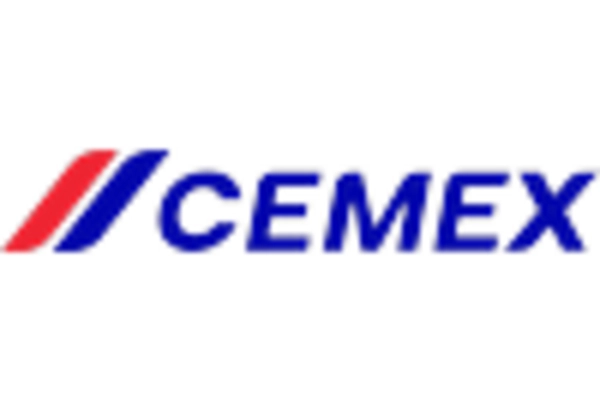Increased Focus on Safety Standards
An increased focus on safety standards within the construction industry is influencing the sprayed concrete market. Regulatory bodies are implementing stricter guidelines to ensure the safety and durability of construction materials. Sprayed concrete, known for its structural integrity and fire resistance, aligns well with these safety requirements. As construction firms strive to comply with these regulations, the adoption of sprayed concrete is expected to grow. The market is likely to see a shift towards materials that not only meet safety standards but also enhance the overall quality of construction projects. This trend indicates a promising future for the sprayed concrete market as safety becomes a priority.
Government Infrastructure Investments
Government investments in infrastructure development are significantly impacting the sprayed concrete market. With initiatives aimed at upgrading aging infrastructure, such as bridges, tunnels, and highways, the demand for sprayed concrete is likely to increase. The US government has allocated substantial budgets for infrastructure projects, with an estimated $1 trillion earmarked for improvements over the next decade. This financial commitment suggests a robust market for sprayed concrete, as it is often utilized in repair and reinforcement applications. Consequently, the sprayed concrete market is poised to benefit from these investments, as contractors turn to this material for its efficiency and effectiveness in meeting project requirements.
Growth in Mining and Tunneling Activities
The sprayed concrete market is also being driven by the growth in mining and tunneling activities across the US. As urbanization continues to expand, the need for underground construction is becoming increasingly prevalent. Sprayed concrete is widely used in tunneling projects due to its ability to provide immediate support and stability to excavated areas. The mining sector, which has seen a resurgence in recent years, is expected to contribute to the sprayed concrete market's growth. With the US mining industry projected to reach a value of $100 billion by 2026, the demand for sprayed concrete in these applications is likely to rise, further solidifying its role in the market.
Rising Demand for Durable Construction Materials
The sprayed concrete market is experiencing a notable increase in demand for durable construction materials. This trend is driven by the need for long-lasting structures in various sectors, including residential, commercial, and infrastructure projects. Sprayed concrete offers superior strength and resistance to environmental factors, making it an attractive option for builders. In the US, the construction industry is projected to grow at a CAGR of approximately 5% over the next few years, which is likely to further boost the sprayed concrete market. As construction companies seek materials that can withstand harsh conditions, the adoption of sprayed concrete is expected to rise, thereby enhancing its market presence.
Technological Innovations in Application Techniques
Technological innovations in application techniques are reshaping the sprayed concrete market. Advances in equipment and methods have improved the efficiency and effectiveness of sprayed concrete applications. For instance, the introduction of robotic spraying systems and automated mixing technologies has streamlined the application process, reducing labor costs and time. These innovations are particularly beneficial in large-scale projects, where precision and speed are crucial. As construction companies increasingly adopt these advanced techniques, the sprayed concrete market is likely to expand. The potential for enhanced performance and reduced waste suggests a favorable outlook for the sprayed concrete market as technology continues to evolve.

















Leave a Comment